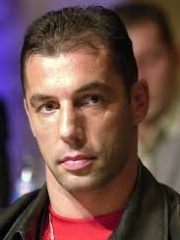
The Most Famous
MARTIAL ARTS from Switzerland
This page contains a list of the greatest Swiss Martial Arts. The pantheon dataset contains 118 Martial Arts, 1 of which were born in Switzerland. This makes Switzerland the birth place of the 16th most number of Martial Arts behind Ireland and Ukraine.
Top 1
The following people are considered by Pantheon to be the most legendary Swiss Martial Arts of all time. This list of famous Swiss Martial Arts is sorted by HPI (Historical Popularity Index), a metric that aggregates information on a biography’s online popularity.

1. Andy Hug (1964 - 2000)
With an HPI of 54.19, Andy Hug is the most famous Swiss Martial Arts. His biography has been translated into 23 different languages on wikipedia.
Andreas "Andy" Hug (7 September 1964 – 24 August 2000) was a Swiss karateka and kickboxer who competed in the heavyweight division. Considered to be one of the greatest heavyweight kickboxers of all time, Hug was renowned for his ability to execute numerous kicking techniques rarely seen in high-level competition. Although he was usually smaller than his opponents, standing at 1.80 m (5 ft 11 in) and being barely a heavyweight, weighing around 98.0 kg (216.1 lb; 15.43 st) in his prime, he made up for his lack of size with his tremendous athleticism and speed. A southpaw, his trademark kicks included the axe kick and the "Hug Tornado", a low spinning heel kick targeting his opponents' thighs. Raised in Wohlen, Aargau, Hug was a keen footballer in his youth but gave up the sport to pursue Kyokushin karate which he began practicing at ten years old. Beginning his full contact karate career in the 80 kg/176 lb middleweight division, he rose to prominence in the late 1970s and early 1980s by winning numerous regional tournaments around Europe and made the transition to heavyweight in 1984. That same year, he competed in the Kyokushin World Open, knockdown karate's most prestigious competition, for the first time and made it to the fourth round where he was eliminated by Shokei Matsui. Returning to Europe, he won his first major title in the form of the 3rd European Championships in 1985 before entering World Open again in 1987. He became the first non-Japanese fighter to make it to the final of the competition but again lost to Shokei Matsui. Another European Championships win would follow in 1989 and he fought in his third and final World Open in 1991, losing a controversial bout to Francisco Filho in the third round. Having become a popular fighter in Japan due to his technical diversity, spectacular aesthetics, tactics and strength, Andy Hug made the switch from Kyokushinkaikan to Seidokaikan in 1992, completing the step from being an amateur to becoming a professional fighter and star in Japan. After winning the 1992 Seidokaikan Karate World Cup, beating Taiei Kin in the final, and finishing as runner-up to Masaaki Satake in the 1993 edition, Hug then transitioned to K-1 kickboxing, scoring a first round knockout of Ryuji Murakami in his professional debut at K-1 Andy's Glove in November 1993. After a breakout win over K-1 Grand Prix '93 Champion Branko Cikatić in March 1994, Hug entered the K-1 Grand Prix '94 a month later as one of the tournament favourites but was upset by Patrick Smith via first round stoppage in the quarter-finals. Undeterred, Hug continued to improve his skills for the kickboxing ring and rebounded by winning the Universal Kickboxing Federation (UKF) World Super Heavyweight Championship in December 1994 when he knocked out Rob van Esdonk. He suffered another setback at the K-1 Grand Prix '95 qualifying round when he was stopped by Mike Bernardo but he would have his revenge the following year at the K-1 Grand Prix '96 when he won the tournament by finishing Bernardo with the "Hug Tornado" in the final. He continued to be one of K-1's top contenders in the following years, reaching the final of the K-1 World Grand Prix twice more (in 1997 and 1998) and becoming a three-time world champion by taking the WMTC and WKA titles under Muay Thai rules. In early August 2000, Hug started feeling unwell in Switzerland. On August 17, while training in Japan, he was given a diagnosis of acute leukemia. He died, aged 35, a week later in Tokyo, the day after it was made public that he was comatose. Hug's sudden death shocked the martial arts world. His legacy remains as a true legend in kickboxing and knockdown karate, as well as one of the greatest heavyweights in the history of both sports. Hug was the highest paid kickboxer in the world at one point and his matches in his native Switzerland, where he posted a perfect 6–0 record, drew a larger television audience than the tennis matches of Martina Hingis and the games of the Switzerland national football team. In addition to his in-ring accomplishments, he was also known for his articulation, humility and strong work ethic. Hug was ranked at #79 on The Top 100 Historical Persons in Japan, a television program aired on Nippon Television on May 7, 2006 which featured the results of a survey that asked Japanese people to choose their favorite great person from history.
Pantheon has 1 people classified as martial arts born between 1964 and 1964. Of these 1, none of them are still alive today. The most famous deceased martial arts include Andy Hug.







